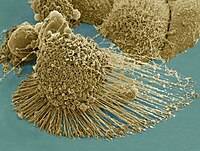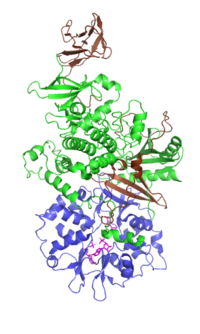
Probing the interaction of a quercetin bioconjugate with Bcl‐2 in living human cancer cells with in‐cell NMR spectroscopy
Sign Up to like & getrecommendations! Published in 2018 at "FEBS Letters"
DOI: 10.1002/1873-3468.13250
Abstract: In‐cell NMR spectroscopy has emerged as a powerful technique for monitoring biomolecular interactions at an atomic level inside intact cells. However, current methodologies are inadequate at charting intracellular interactions of nonlabeled proteins and require their… read more here.
Keywords: human cancer; living human; nmr spectroscopy; cell nmr ... See more keywords

Human cancer evolution in the context of a human immune system in mice
Sign Up to like & getrecommendations! Published in 2018 at "Molecular Oncology"
DOI: 10.1002/1878-0261.12374
Abstract: Immunotherapy is one of the most promising cancer treatment modalities, but the lack of appropriate preclinical in vivo models hampers the development of novel immunotherapeutic strategies. Here, we studied the ability of transplanted human cancer… read more here.
Keywords: human cancer; system mice; immune system; cancer ... See more keywords

Upregulation of BAX and caspase‐3, as well as downregulation of Bcl‐2 during treatment with indeno[1,2‐b]quinoxalin derivatives, mediated apoptosis in human cancer cells
Sign Up to like & getrecommendations! Published in 2022 at "Archiv der Pharmazie"
DOI: 10.1002/ardp.202100454
Abstract: Cancer is the world's foremost cause of death. There are over 100 different forms of cancer. Cancers are frequently named after the organs or tissues in which they develop. As a part of our aim… read more here.
Keywords: cell; cell line; human cancer; downregulation bcl ... See more keywords

High‐Resolution Imaging of Human Cancer Proteins Using Microprocessor Materials
Sign Up to like & getrecommendations! Published in 2022 at "ChemBioChem"
DOI: 10.1002/cbic.202200310
Abstract: Mutations in tumor suppressor genes, such as Tumor Protein 53 (TP53), are heavily implicated in aggressive cancers giving rise to gain‐ and loss‐of‐function phenotypes. While individual domains of the p53 protein have been studied extensively,… read more here.
Keywords: microprocessor; high resolution; human cancer; resolution imaging ... See more keywords

Synonymous Somatic Variants in Human Cancer Are Not Infamous: A Plea for Full Disclosure in Databases and Publications
Sign Up to like & getrecommendations! Published in 2017 at "Human Mutation"
DOI: 10.1002/humu.23163
Abstract: Single‐nucleotide variants (SNVs) are the most frequent genetic changes found in human cancer. Most driver alterations are missense and nonsense variants localized in the coding region of cancer genes. Unbiased cancer genome sequencing shows that… read more here.
Keywords: cancer infamous; human cancer; somatic variants; synonymous somatic ... See more keywords

Cardiac glycosides stimulate endocytosis of GLUT1 via intracellular Na+,K+‐ATPase α3‐isoform in human cancer cells
Sign Up to like & getrecommendations! Published in 2022 at "Journal of Cellular Physiology"
DOI: 10.1002/jcp.30762
Abstract: Glucose transporter GLUT1 plays a primary role in the glucose metabolism of cancer cells. Here, we found that cardiac glycosides (CGs) such as ouabain, oleandrin, and digoxin, which are Na+,K+‐ATPase inhibitors, decreased the GLUT1 expression… read more here.
Keywords: cancer; atpase isoform; glut1; human cancer ... See more keywords

Efficacy of Methionine-Restricted Diets on Cancers In Vivo.
Sign Up to like & getrecommendations! Published in 2019 at "Methods in molecular biology"
DOI: 10.1007/978-1-4939-8796-2_7
Abstract: Methionine (MET) dependence is the elevated requirement of cancer cells for MET. Cancer cells are arrested when MET is restricted in late S/G2 phase of the cell cycle. MET dependence may be the only known… read more here.
Keywords: methionine; met dependence; human cancer; vivo efficacy ... See more keywords

A new pyridazinone exhibits potent cytotoxicity on human cancer cells via apoptosis and poly-ubiquitinated protein accumulation
Sign Up to like & getrecommendations! Published in 2019 at "Cell Biology and Toxicology"
DOI: 10.1007/s10565-019-09466-8
Abstract: In the last 15 years, pyridazinone derivatives have acquired extensive attention due to their widespread biological activities and pharmacological applications. Pyridazinones are well known for their anti-microbial, anti-viral, anti-inflammatory, anti-cancer, and cardiovascular activities, among others. In… read more here.
Keywords: cell; apoptosis; human cancer; cancer ... See more keywords

Identification of N-arylsulfonylpyrimidones as anticancer agents
Sign Up to like & getrecommendations! Published in 2018 at "Archives of Pharmacal Research"
DOI: 10.1007/s12272-018-1003-9
Abstract: For confirming the role of five membered ring of imidazolidinone moiety of N-arylsulfonylimidazolidinones (7) previously reported with highly potent anticancer agent, a series of N-arylsulfonylpyrimidones (10a–g) and N-arylsulfonyltetrahydropyrimidones (11a–e) were prepared and their anti-proliferating activity… read more here.
Keywords: cell lines; human cancer; arylsulfonylpyrimidones anticancer; identification arylsulfonylpyrimidones ... See more keywords

Precision Targeting of BFL-1/A1 and an ATM Co-dependency in Human Cancer.
Sign Up to like & getrecommendations! Published in 2018 at "Cell reports"
DOI: 10.1016/j.celrep.2018.08.089
Abstract: Cancer cells overexpress a diversity of anti-apoptotic BCL-2 family proteins, such as BCL-2, MCL-1, and BFL-1/A1, to enforce cellular immortality. Thus, intensive drug development efforts have focused on targeting this class of oncogenic proteins to… read more here.
Keywords: bfl; precision targeting; human cancer; bfl atm ... See more keywords

Sam68 Allows Selective Targeting of Human Cancer Stem Cells.
Sign Up to like & getrecommendations! Published in 2017 at "Cell chemical biology"
DOI: 10.1016/j.chembiol.2017.05.026
Abstract: Targeting of human cancer stem cells (CSCs) requires the identification of vulnerabilities unique to CSCs versus healthy resident stem cells (SCs). Unfortunately, dysregulated pathways that support transformed CSCs, such as Wnt/β-catenin signaling, are also critical… read more here.
Keywords: cancer stem; human cancer; targeting human; stem ... See more keywords